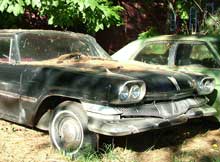Throwing Darts
Until 1959, Chrysler Corporation had its own version of Sloanism, a car for every purse and purpose. Plymouth, at the bottom, sold for $2,143 to $3,131, Dodge a notch higher at $2,516 to $3,439. DeSoto weighed in above Dodge and finally Chrysler, with its premium Imperial series, above that. In an unusual marketing strategy, all Dodge, DeSoto and Chrysler dealers also sold Plymouth as a volume leader.
But suddenly, as the ads had promised since 1957, it was 1960 and all that went out the window. Dodge dealers were shorn of their Plymouth franchises and instead given a new low-priced Dart model that was a Plymouth in Dodge dress. Perhaps this was to mute the effect of the new compact Valiant that, while not actually badged as a Plymouth, was sold in Plymouth showrooms. In any case, the cheapest Dodge, a Dart Seneca, sold for $2,278, just eight dollars more than the least expensive Plymouth. There were two more upscale Dart series, Pioneer and Phoenix, as well as the full-size Matador and Polara.
This scheme continued into 1961, with Darts Seneca, Pioneer and Phoenix opposite Plymouth and a single "big" Polara modle, but greater inroads were made into Plymouth territory with the Lancer, a Valiant clone. Dart series were renamed in 1962, with the base model simply "Dart" and the more upscale cars called Dart 330 and Dart 440. The Lancer continued, in two-door, four-door and station wagon form. The only large Dodge was now the Polara 500.
The Dart was a phenomenal success. In its first year, 306,603 cars easily outpaced the 253,432-car volume of the full-sized Plymouth. Ensuing seasons were not so heady, but Dart sales nicely offset the dealers' lack of Plymouth product. The Lancer, however, sold at only half Valiant's volume, so for 1963 it was dropped, replaced by a longer-wheelbase new Dart. With sedan, hardtop, station wagon and convertible models, it caught on, and became Dodge's volume leader. It remained so through 1965 and to the end of production in 1976. A GT coupe also became available. Meanwhile, the 330 and 440 became full-size Dodges, companion to Polara. In 1962, after all Dodges were downsized, dealers begged for a larger car, so the factory mated a Dodge front end to a Chrysler Newport, begetting the Dodge Custom 880.
The Dodge lineup now virtually doubled with Plymouth, and more besides. By the time the Dodge Aspen and Plymouth Volare were introduced in 1976, comparable models were very closely priced, some exactly the same. Plymouth lasted another quarter century, but the handwriting was on the wall. The company was competing against itself, and eventually the weaker brother lost.

